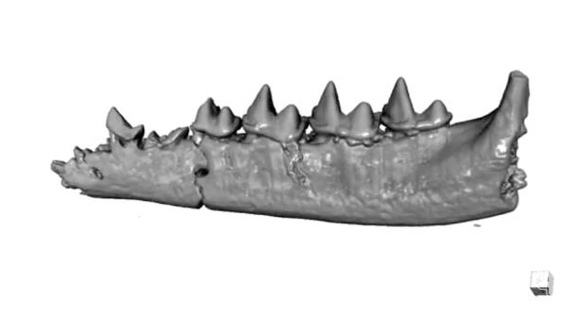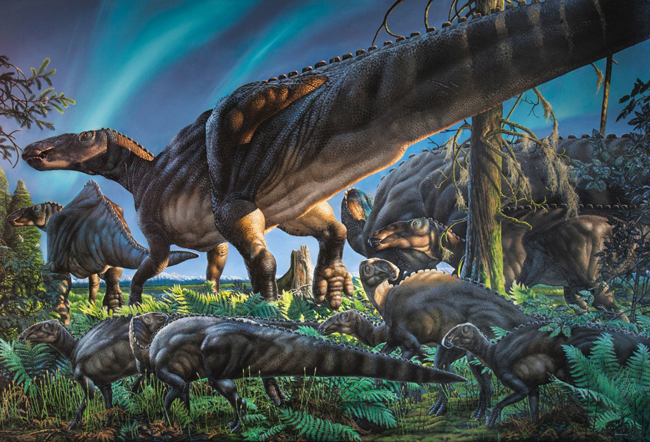Mini Marsupial Lived Amongst Arctic Dinosaurs (New Fossil Discovery)
Unnuakomys hutchisoni – Late Cretaceous of Alaska
Researchers have discovered a new species of ancient marsupial that lived deep in the Arctic Circle approximately 69 million years ago (lower Maastrichtian faunal stage). The new mammal has been named Unnuakomys hutchisoni, not much bigger than a house mouse (Mus musculus), it is likely that this little creature was nocturnal and may have retreated to burrows to protect itself from periods of extreme cold. Known from more than sixty fossil specimens, the vast majority being tiny teeth but two dentaries (lower jaw bones ) were found along with a fragment of upper jaw (maxilla), this little mammal helps to flesh out the rich, diverse and unique Late Cretaceous biota of Alaska.
Little Mammals Such as the Marsupial Unnuakomys hutchisoni Lived in the Shadow of Dinosaurs

Picture credit: James Havens
Fossils from the Pediomys Point Locality
For several years now, researchers have been exploring the Upper Cretaceous strata that is exposed along the steep banks of the Colville River. The researchers, which include lead author of the paper on Unnuakomys hutchisoni, Jaelyn Eberle (University of Colorado) and her collaborator Patrick Druckenmiller (University of Fairbanks Alaska), have uncovered evidence of a unique assemblage of dinosaurs and the discovery of this little marsupial represents the most northern of this type of mammal known to science. The climate during the Late Cretaceous in this part of the world was not as severe as it is today, but the animals living this far north would have had to endure around four months of complete darkness each year and the temperatures would frequently drop below freezing. The fossil material representing U. hutchisoni was collected during the sieving of sediments from the Pediomys Point Locality of the Prince Creek Formation exposed along the Colville River on the North Slope of Alaska.
Field Team Members Pose Next to Buckets of Sediment Ready for Sieving

Picture credit: Jaelyn Eberle
A Diverse Faunal Assemblage
This part of Alaska was some 80 degrees north around 69 million years ago. It was once thought that these high latitudes were virtually devoid of life, but that view has gradually changed as more fossil discoveries have been made. Teeth of U. hutchisoni greatly outnumber those recovered from other mammals at Pediomys Point, this could be down to sampling, or it could have arisen due to a preservation bias, perhaps the remains of this tiny mammal were more likely to be preserved than other mammal bones and teeth, although this is unlikely. The abundance of Unnuakomys fossils in relation to other mammals could indicate that this tiny animal thrived in an environment well above the Arctic Circle whose climatic extremes may have acted as a biogeographical barrier preventing the encroachment of other types of Late Cretaceous mammal.
Field Team Members Working on a Steeply Sloping Riverbank
Picture credit: Patrick Druckenmiller
Patrick Druckenmiller stated:
“Northern Alaska was not only inhabited by a wide variety of dinosaurs, but in fact we’re finding there were also new species of mammals that helped to fill out the ecology. With every new species, we paint a new picture of this ancient polar landscape.”
“Night Mouse”
In a reflection of the likely ecology of this miniature marsupial, that of an animal well-adapted to living in the dark, Eberle and her colleagues gave the new mammal the genus name Unnuakomys, a mixture of Greek and the indigenous Iñupiaq language that means “night mouse.” The trivial name honours the palaeontologist J. Howard Hutchison, who was the first person to identify and explore this fossil assemblage.
The research team, whose project was funded with a National Science Foundation grant, identified the new marsupial using a painstaking process. With the help of numerous graduate and undergraduate students, they collected, washed and screened ancient river sediment collected on the North Slope and then carefully inspected it under a microscope. Over many years, they were able to locate numerous fossilised teeth, most of which were no bigger than a grain of sand.
Co-author of the paper, Gregory Erickson (Florida State University), explained:
“I liken it to searching for proverbial needles in haystacks, more rocks than fossils.”
Unnuakomys hutchisoni – Find the Teeth and Identify the Mammal
By far the most durable part of most mammal skeletons are the teeth, thanks to their coating of hard enamel. It is the shape of the teeth and their wear pattern, particularly the shape of the molars that allow palaeontologists to identify the type of mammal they have found simply by examining the teeth. Mammalian teeth have unique cusps on the crown that differ from species to species and they, as a result, are highly diagnostic. The triangular cusps on the teeth of U. hutchisoni are reminiscent of the triangular blades associated with pinking shears and are typical of an insectivore.
A Computer Generated Image Showing the Lower Jaw (Dentary) of Unnuakomys hutchisoni
Picture credit: University of Colorado Boulder
Other co-authors of the Journal of Systematic Palaeontology paper include William Clemens (University of California), Paul McCarthy (University of Alaska Fairbanks) and Anthony Fiorillo of the Perot Museum of Nature and Science.
Recycling a Scientific Illustration
In 2015, Everything Dinosaur reported upon the discovery of a unique species of Alaskan hadrosaur (Ugrunaaluk kuukpikensis), James Havens produced an exquisite piece of art showing a herd of these duck-billed dinosaurs moving through the Late Cretaceous, Alaskan landscape. To illustrate the likely position of U. hutchisoni in this ecosystem, the original artwork was carefully photoshopped to permit the inclusion of the little mammal (see inset above). As our understanding of the fauna and flora of Late Cretaceous Alaska evolves, the artwork may have to be altered again, in the meantime, we have an excuse to show the original illustration once more.
The Original Ugrunaaluk kuukpikensis Life Reconstruction (2015)
Picture credit: James Havens
To read our article about U. kuukpikensis: Latest Dinosaur Discovery from Alaska.
The scientific paper: “Northernmost record of the Metatheria: A New Late Cretaceous Pediomyid from the North Slope of Alaska” by Jaelyn J. Eberle, William A. Clemens, Paul J. McCarthy, Anthony R. Fiorillo, Gregory M. Erickson and Patrick S. Druckenmiller published in the Journal of Systematic Palaeontology
Everything Dinosaur acknowledges the assistance of a press release from the University of Alaska Fairbanks in the compilation of this article.
Visit the Everything Dinosaur website: Everything Dinosaur.




